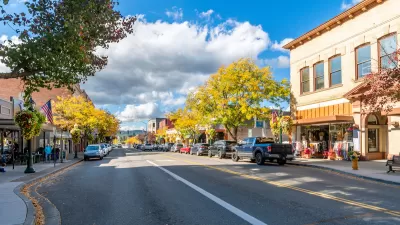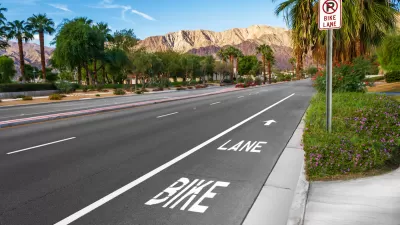With nearly half of U.S. road deaths occurring on rural roads, the Complete Streets approach offers a safer way forward, but few towns are taking it on.

In a piece in Smart Growth America, Abigail Araya reminds readers that Complete Streets and pedestrian infrastructure are not exclusively urban needs.
Araya quotes a recent SGA report that makes the case for a Complete Streets approach to rural roads as one way to reduce road deaths and build thriving, multimodal rural communities. According to the report, “as rural areas account for 49% of all traffic deaths (while only 19% of the population lives in these areas), decision makers must prioritize pedestrian design that put safety at the forefront.”
The report points out that of the 18 projects that received federal Rural Transportation Surface Grants for 2023–2024, just two included a Complete Streets approach. “However, while some pedestrian design features were tacked on to these projects, they ultimately follow the default approach to road design, prioritizing vehicle speed and throughput over the safety of other road users.”
The report concludes that a few piecemeal design components aimed at pedestrians and cyclists are not enough to end road deaths and create truly multimodal systems. “Following a Complete Streets approach means prioritizing the safety of all road users and designing for safety over speed.”
FULL STORY: What it means to follow a Complete Streets approach in rural America

Alabama: Trump Terminates Settlements for Black Communities Harmed By Raw Sewage
Trump deemed the landmark civil rights agreement “illegal DEI and environmental justice policy.”

Study: Maui’s Plan to Convert Vacation Rentals to Long-Term Housing Could Cause Nearly $1 Billion Economic Loss
The plan would reduce visitor accommodation by 25% resulting in 1,900 jobs lost.

Planetizen Federal Action Tracker
A weekly monitor of how Trump’s orders and actions are impacting planners and planning in America.

Waymo Gets Permission to Map SF’s Market Street
If allowed to operate on the traffic-restricted street, Waymo’s autonomous taxis would have a leg up over ride-hailing competitors — and counter the city’s efforts to grow bike and pedestrian on the thoroughfare.

Parklet Symposium Highlights the Success of Shared Spaces
Parklets got a boost during the Covid-19 pandemic, when the concept was translated to outdoor dining programs that offered restaurants a lifeline during the shutdown.

Federal Homelessness Agency Places Entire Staff on Leave
The U.S. Interagency Council on Homelessness is the only federal agency dedicated to preventing and ending homelessness.
Urban Design for Planners 1: Software Tools
This six-course series explores essential urban design concepts using open source software and equips planners with the tools they need to participate fully in the urban design process.
Planning for Universal Design
Learn the tools for implementing Universal Design in planning regulations.
Caltrans
Smith Gee Studio
Institute for Housing and Urban Development Studies (IHS)
City of Grandview
Harvard GSD Executive Education
Toledo-Lucas County Plan Commissions
Salt Lake City
NYU Wagner Graduate School of Public Service





























